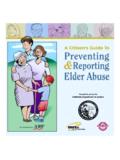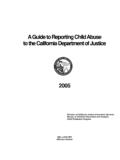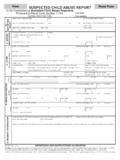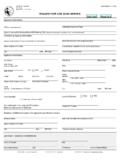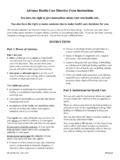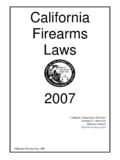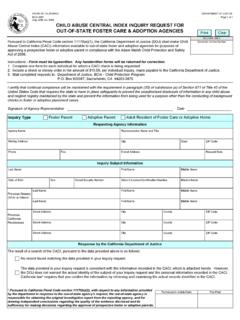Transcription of Handgun Safety Certificate - ag.ca.gov
1 HSC. Handgun Safety Certi cate study GUIDE. California Department of Justice Office of the Attorney General California Department of JustiCe Bureau of firearms JANUARY 2012. P R E F A C E. Handgun Safety is the law in California. Every Handgun owner should understand and follow Handgun Safety practices, have a basic familiarity with the operation and handling of a Handgun , and be fully aware of the respon . sibility of Handgun ownership. Pursuant to Penal Code section 26840, subdivision (b), any person who acquires a Handgun must have a Handgun Safety Certificate (HSC), unless they are exempt from the HSC. requirement. In order to obtain an HSC, a person must pass a Department of Justice (DOJ) written test on Handgun Safety . The test is administered by DOJ.
2 Certified Instructors, who are often located at firearms dealerships. This study guide provides you with the basic Handgun Safety information necessary to pass the test. Following the Handgun Safety information in this guide will also help reduce the potential for accidental deaths and injuries, particularly those involving children, caused by the unsafe handling and storing of handguns. Included in this study guide is a general summary of the laws that govern the sale and use of firearms. A glossary is also provided at the end of this study guide that contains definitions of the more technical terms used. Simply reading this study guide will not make you a safe Handgun owner. To be a safe Handgun owner you must practice the Handgun Safety procedures described in the following pages.
3 Table of Contents Introduction Why Handgun Safety ? .. 5. Handgun Safety is the Law .. 5. Handgun Safety Certificate Information .. 5. Safe Handling Demonstration .. 6. Causes of Handgun Accidents .. 6. Preventing Misuse Tragedies .. 7. Becoming a Safe and Responsible Handgun Owner .. 7. Chapter 1: Gun Safety Rules The Six Basic Gun Safety Rules .. 9. Additional Safety Points.. 11. Chapter 1: Self Test .. 12. Chapter 2: Handguns and Children Handgun Owner Responsibility .. 13. Summary of Safe Storage Laws Regarding Children .. 13. You Cannot Be Too Careful with Children and Guns .. 13. Talking to Children about Guns .. 14. Instill a Mind Set of Safety and Responsibility .. 14. Rules for Kids .. 14. Chapter 2: Self Test .. 16. Chapter 3: Handgun Operation Types of Handguns.
4 17. Revolver Parts and Operation.. 17. Parts of a Revolver .. 17. How a Revolver Works .. 17. To Load a Double-Action Revolver .. 18. To Check or Unload a Double-Action Revolver .. 19. Semiautomatic Pistol Parts and Operation.. 20. Parts of a Semiautomatic Pistol .. 20. How a Semiautomatic Pistol Works .. 20. To Load a Semiautomatic Pistol .. 21. To Check or Unload a Semiautomatic Pistol .. 22. Ammunition .. 23. Ammunition Components .. 23. Components of a Cartridge .. 23. Physics of Gunfire .. 23. Firearm and Ammunition Calibers .. 24. Dangerous Range .. 25. Malfunctions .. 25. Chapter 3: Self Test .. 26. Chapter 4: Handgun Ownership Understand the Safety Aspects of Your Handgun .. 27. Carefully Read All Instructional Material .. 27. Enroll in a Handgun Training Course.
5 27. Cleaning and Repair .. 27. Safety and Storage Devices .. 29. Methods of Childproofing .. 30. Chapter 4: Self Test .. 31. Prohibited Firearms Transfers and Straw Purchases.. 32. Chapter 5: Firearms Laws Introduction to the Laws .. 33. Sales and Transfers of Firearms .. 33. New California Resident Requirement .. 36. Carrying a Concealed Weapon .. 36. Firearms Aboard Common Carriers .. 37. Firearms in the Home, Business or at the Campsite .. 37. The Use of Lethal Force in Self-Defense .. 37. Loaded Firearms in Public .. 38. Miscellaneous Prohibited Acts .. 39. Persons Ineligible to Possess Firearms .. 41. Chapter 5: Self Test .. 43. Appendix Safe Handling Demonstration Steps .. 45. Semiautomatic Pistol.. 45. Double-Action Revolver .. 48. Single-Action Revolver.
6 50. Safe Handling Demonstration Glossary.. 52. Introduction WHY Handgun Safety ? Handgun Safety is important to all Californians. No one wants Handgun accidents to happen yet they do everyday. Handgun accidents involving children are especially disturbing. Studies show that easy access to loaded handguns in homes is a major cause of accidental shootings of children. While there may be no way to guarantee Safety , Handgun owners can take steps to help prevent many accidental shootings. This study guide will give you valuable information to help you become a safe and responsible Handgun owner. Handgun Safety IS THE LAW. The intent of the California Legislature in enacting the Handgun Safety Certificate (HSC) law is to ensure that persons who obtain handguns have a basic familiarity with those firearms, including but not limited to, the safe handling and storage of those firearms.
7 It is not the intent of the Legislature to require an HSC for the mere possession of a firearm. (Pen. Code, 31610.). Handgun Safety CERTIFICATE INFORMATION. To obtain an HSC, you must take the DOJ written test and receive a passing score of at least 75% (the information necessary for passing the test is contained in this study guide). An HSC is valid for five years from the date of issuance. If your HSC is lost, stolen or destroyed, a replacement may be obtained from the DOJ Certified Instructor who issued your original HSC. Pursuant to Penal Code section 31700, there are exemptions from the HSC. requirement based on specific categories of persons. Some of the exempt categories are: Federal Firearms License Collectors with a Certificate of Eligibility (for Curio and Relic transactions only).
8 Active, active reserve, or honorably retired military;. Carry Concealed Weapon (CCW) permit holders; and Persons who have completed Peace Officers Standards and Training (POST). (Pen. Code, 832) firearms training. 5. For a complete list of exemptions visit the DOJ website at or contact the DOJ Bureau of Firearms, General Information Line at (916) 227-7527. You are required to provide documentation of your exemption to the firearms dealer each time you acquire a Handgun . SAFE HANDLING DEMONSTRATION. Prior to taking delivery of a Handgun , you must successfully perform a safe handling demonstration with the Handgun being purchased or acquired. The safe handling demonstration must be performed in the presence of a DOJ Certified Instructor on or after the date the Dealer Record of Sale (DROS) is submitted to the DOJ and before the Handgun is delivered.
9 The appendix at the end of this guide lists each of the statutorily mandated steps that constitute the safe handling demonstration for the three most common Handgun types (semiautomatic pistols, double-action revolvers and single-action revolvers). The appendix is provided to help you prepare for the safe handling demonstration only. The information needed to answer all questions that appear on the DOJ Handgun Safety written test can be found within this study guide. CAUSES OF Handgun ACCIDENTS. Ignorance and carelessness are major causes of Handgun accidents. To help reduce the number of Handgun accidents, it is critical that gun Safety rules are understood and practiced at all times by every family member. Following are some examples of Handgun accidents that could have been avoided if the basic gun Safety rules had been practiced: Two young children playing in their home found a loaded Handgun with the magazine removed on a bedside table.
10 One child was injured when the Handgun was fired. A Handgun owner assumed a Handgun was unloaded. While cleaning it, he accidentally fired the Handgun , causing injury to himself. While practicing target shooting, a shooter was distracted by a noise behind her. She turned with her finger on the trigger and accidently fired, injuring a person standing nearby. Knowing the Safety rules and applying them most of the time is not enough. Handgun accidents can happen even if a person knows the Safety rules, but is careless in practicing them. For example, you may think you can leave your loaded Handgun out on the kitchen table just for a moment while you go outside to turn off the garden hose. Although you know you should never leave a firearm where a child may find it, you carelessly think it will be alright just this once.
